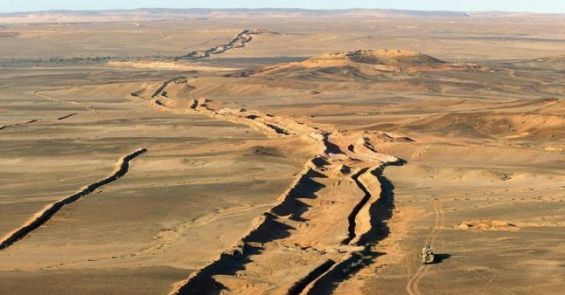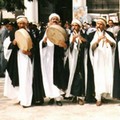On August 16, 1985, the CIA dedicated a document to the Sand Wall built by Morocco in the Sahara. Declassified on January 13, 2012, this document describes the project as the «Great Wall». From the air, the Great Wall «against the Polisario guerrillas runs like a thin, brown welt across the vast gray emptiness of the Sahara, fading into the mirages that shimmer on the horizon», reads the CIA document.
«It runs for more than 1,500 miles, from the Algerian border in the northeast, snaking south, then west, along the Mauritanian frontier toward the Atlantic Ocean through desert so desolate and hot that cameras won’t work, crows won’t fly, and stones are scorched black from the sun», the CIA further details.
«There, amid the Sahara’s sandy void, a 9-foot-high earthen rampart bristles with space-age antipersonnel radar, seismic sensors, artillery, mines, and mechanized infantry units».
An unprecedented defense installation
«For the first time in a decade, Western military experts say, the wall is turning the tide of the war against the Polisario Front in Morocco’s favor», the CIA notes. It also cites Moroccan General Abdelaziz Bennani, commander of the southern military zone at the time, as «the main architect of the wall strategy».
In this context, American intelligence emphasizes the unprecedented nature of this construction, describing it as having «no precedent in history». According to the agency, the wall «consists of hundreds of strong points spaced at about 2-mile intervals along the elevated sand embankment. Each strong point protects its neighbor with overlapping fire, while small mechanized units have been deployed nearby to intercept any Polisario guerrillas who manage to reach the wall».
«With few means, we are maintaining sufficient strength all along the wall. It obliges the Polisario to engage our forces on our terms», the document states.
The CIA also reveals that «the last time the Polisario soldiers reportedly tried to breach the Wall in strength was last October (1984), when Moroccan troops proved the general’s point with deadly efficiency». The document explains that when the Polisario militias approached the wall, they were caught in crossfire, resulting in the death of dozens of them and the destruction or seizure of more than twenty vehicles by the Moroccan side.
A turnaround for the region’s security situation
On the ground and in the eyes of the CIA, the Wall of Sand represented a significant turnaround in the region’s security situation. The reason was that the Polisario militias no longer dared to approach it. Since then, according to Moroccan officials, the rebels of the separatist movement have been kept at a distance, limiting themselves to occasional and limited maneuvers, using missiles and then quickly withdrawing before Moroccan radars could trace their location.
The document also confirmed that a year earlier, the Polisario Front had claimed control over two-thirds of the Sahara region. But «when Morocco completes the western sector of the wall to the Atlantic in about 10 years, Western military experts say the guerrillas will hold less than one-third of the former Spanish colony».
For all these reasons, according to the CIA document, the wall has attracted «the attention of both US and Soviet military experts» as one of the few «successful applications of technology against guerrilla insurgencies». US intelligence further notes: «The Moroccan authorities would not disclose the cost of constructing the wall, but Western military experts estimate it at $10 million».
«The nature of the rebellion has changed. Before, it was a matter of insurgents on foot or in Jeeps. Now, it’s a matter of insurgents using tanks and SAM-6 missiles. The wall has been adapted to the new situation», General Abdelaziz Bennani explained. «Our defense consists of driving the Polisario back to their bases. We don’t want war to engulf North Africa. We want to stop a war, not start one», he insisted.
Among the benefits of the Wall of Sand, the CIA mentions «the reduction of tension and economic uncertainty in southern Morocco». A year earlier, Laayoune had been «a frequent target of Polisario attacks». But once the berm was erected, «a new Club Med opened» in the coastal city, offering «scuba diving and overnight trips with Jeeps into the desert».




 chargement...
chargement...












